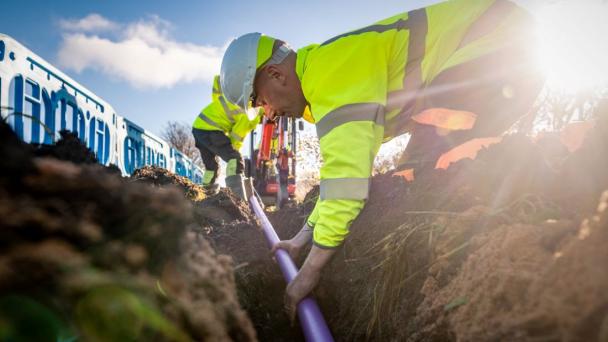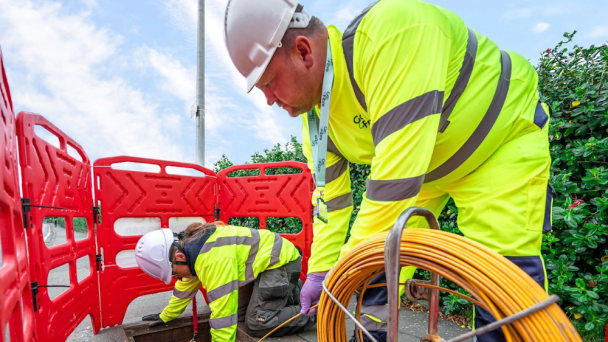APFN has signed a deal to provide business-grade FTTP connections to Onecom customers through the aquila platform that will allow the reseller to immediately broaden its offering.

Following the publication of Megabuyte’s latest full fibre quarterly update Chief Analyst Philip Carse reads between the FTTP lines with astute financial and strategic analysis of telco majors Openreach, VMO2 and altnet CityFibre.
Against the backdrop of increasing broadband losses, with Openreach in particular highlighting softness in this regard while VMO2 saw some growth (albeit just 10k net adds), both incumbents ramped up their FTTP annualised build rates to 3.8m (+400k) for Openreach and 1.2m (+200k) for VMO2 (on behalf of nexfibre). Meanwhile, CityFibre continued to report increasing uptake with circa 60k net adds in its December quarter, on a softer build rate going forward with the delta to be plugged with M&A – as highlighted by its recent acquisition of Lit Fibre. The biggest change to the status quo came from VMO2 with the announcement of its at-scale wholesale offering NetCo which will encapsulate VMO2’s circa 17m premises in a wholesale infrastructure challenger network to Openreach.
Openreach’s December 2023 quarter KPIs
In the December 2023 quarter (Q3 FY24), Openreach added 950k premises to its UK FTTP footprint (just shy of its 1m per quarter target) versus the 860k added in the quarter to September, taking the total to just under 13m premises, over half of its initial 25m target, and almost as much as all the altnets combined.
Openreach also added 423k FTTP customers (mostly upgrades from FTTC-base broadband) via its consumer and enterprise retail arms as well as third party ISPs such as Vodafone, Sky and Talktalk, taking the total FTTP connections to 4.3m. This total is an order of magnitude (2-3x) higher than the combined altnet connections, reflecting the easier job of upgrading existing customers to FTTP versus having to attract new customers.
Penetration is still rising on the back of an increased build, with this being the main feature of Openreach’s performance of the last year. Penetration of FTTP premises has risen to 33.6%, up from 28.5% the previous year. Interestingly, however, expected Openreach net broadband losses are on track to be higher than the previously flagged 400k for the full year, with calendar 2023 showing 437k net losses and the nine months to December 2023 at 370k losses – reflective of a weakening consumer landscape and likely increased competition from altnets now more focused on gaining customers than building networks as constraints on funding continues.
Openreach’s longer-term targets
In its full year 2023 results release, Openreach reaffirmed its target of 25m FTTP premises by the end 2026. This requires a quarterly build of 1m premises (versus last quarter’s 950k and an average of 808k in the last four reported quarters). Openreach is coming in under its capex guidance of £250-£350 per premise by virtue of improving FTTP build unit costs, and is now expecting FY24 FCF towards the top end of previously flagged £1.0-£1.3bn guidance. Beyond 2024 Openreach continues to expect consistent growth in revenue and EBITDA.
Fibre investment is a key element in Openreach’s target of at least doubling FCF by the end of the decade (an extra £1.5bn+), reflecting revenue and EBITDA growth and a £1bn lower annual capex bill from FY28, when the bulk of the FTTP build is done. This also factors in opex savings from moving to a full fibre, all-IP network, resulting in target headcount reductions from 130k to 75-90k and lower network maintenance costs.
VMO2’s December 2023 quarter KPIs
VMO2’s December quarter also saw an uptick in premises passed, with 298k added in the quarter, and 832k in the year (excluding UPP premises where integration is pending), albeit the majority were built on behalf of nexfibre. This takes the total network footprint to 17m (circa 50% of UK premises), of which around 3m is FTTP (seemingly unchanged since it first disclosed this figure last summer) with upgrade costs coming in at approximately £100 per home. Meanwhile, nexfibre’s total footprint now sits at circa 830k (Q3: 505k), with ‘immaterial’ overbuild of UK altnets according to management, on a maintained target of 5m premises by 2026 and then up to 7m thereafter.
Liberty Global’s brainchild – NetCo
In an increasingly third party ISP-driven consumer broadband market, as shown by Openreach’s increasingly third party heavy broadband mix (currently at 43% of connections, up from 23% two years ago), it makes sense for VMO2 to launch an at-scale wholesale network offering, although, it won’t be in effect for some time. This opens up more optionality with regards to funding and participation in the altnet consolidation, with VMO2 showing an appetite last year with the acquisition of Upp.
In terms of its corporate structure, VMO2 will contract through a wholesale agreement with NetCo, connecting its entire fixed customer base, meaning that NetCo will be revenue generating and cashflow positive from day one. It’s worth noting that nexfibre (already wholesale focused) will continue to operate separately and focus on the fibre expansion on top of VMO2’s existing circa 17m base, which VMO2 is in the process of upgrading from HFC to FTTP (circa 3m completed). NetCo is expected to go live in H1 2025, subject to regulatory approval.
NetCo throws a spanner in the works for wholesale focused altnets such as CityFibre, potentially giving its larger ISP partners another choice where the CityFibre network overlaps VM02’s, as well as creating some real competition in terms of a consolidation vehicle. On the customer front, this will also introduce new offerings and possibly lower prices, shifting the economics of the fibre play and putting pressure on the altnet business plans.
Wholesale challenger CityFibre
The latest update from CityFibre highlighted that its network now encompasses 3.2 million premises RFS and is servicing 340k subscribers (December 2023). On the commercialisation front, CityFibre added circa 60k subscribers in the December quarter, versus 10k net adds for VMO2 and 114k net losses for Openreach. In terms of build, CityFibre will slightly temper its build rate from the 1m of FY23 to 850k in FY24, with the delta to be filled by M&A – as highlighted by the Lit Fibre buy. In terms of financials, the altnet topped £100m revenues in FY23 (calendar) and is set to be EBITDA positive in H1 2024.
In tune with its ‘challenger’ network branding, its 340k customers (up 165k in the year versus 115k in 2022) are serviced though 41 ISP partners selling at two to three times the rate they do over Openreach’s network, helped by CityFibre’s lower wholesale prices and product portfolio (symmetric speeds versus Openreach’s asymmetric broadband). Meanwhile, its latest KPIs reflect increasingly positive noises with a 10.5% (+2.3%) RFS penetration and 9.6% THP (+2.6pp). And proposition-wise, CityFibre is launching a new B2B FTTP product which will help commercialise business premises passed as part of the overall build. This would appear to be well timed given the looming (end 2025) switch off of BT’s PSTN network and related analogue services such as broadband, although CityFibre’s RFS business premises sit at just circa 200k, representing little competitive threat to incumbent Openreach.
Signs of meaningful consolidation
During the quarter, CityFibre emerged as the buyer of altnet Lit Fibre on an all-share basis. According to Sky News, Newlight will receive 2% of the combined entity valuing the transaction at circa £80m equity. Lit Fibre brings a footprint of 200k premises RFS (built on a compatible XGS-PON framework) with planning for a further 100k to be added by 2025. Its retail ISP currently services 9k subscribers – this compares with CityFibre’s 3.2m RFS network and 340k subscribers at December 2023.
Looking deeper, Lit Fibre’s rumoured £80m valuation equates to £400 per premise RFS – we suspect significantly below invested capital. If £80m/£400 per premises RFS is the true enterprise value, one suspects that Lit Fibre investor Newlight hopes to recapture some return by being part of a larger organisation (with CityFibre’s rumoured £4bn valuation alluding to £1,250 per premise RFS, a significant premium on Lit Fibre), leaving CityFibre to fund the network build and customer connection cost.
More broadly, CityFibre is set to play a critical role in the consolidation as its current 3.2m footprint also leaves a large acquirable base out of the 32m serviceable premises in the UK, which is less apparent for Openreach whose current addressable base (all connectivity mediums) sits at circa 29m and VMO2’s at around 17m, with the former also flagging little to no M&A appetite.




